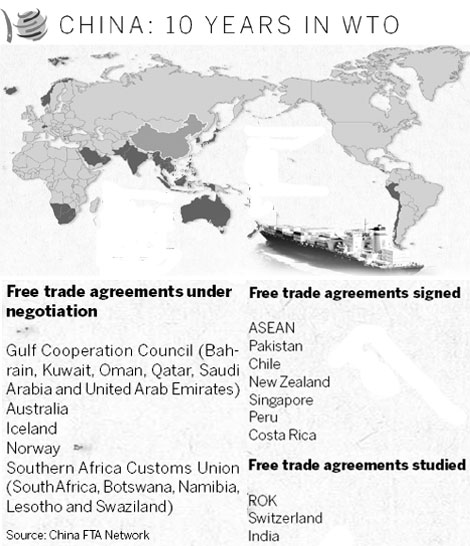Nation moving quickly to establish more multilateral free trade areas
Updated: 2011-12-06 07:58
By Bao Chang (China Daily)
|
|||||||||||

BEIJING - China will make great progress in establishing multilateral free trade areas (FTA) in the next few years, after a decade's efforts to promote bilateral FTAs since the nation entered the World Trade Organization (WTO) in 2001.
During the first China-Eurasia Expo held in Urumqi in the Xinjiang Uygur autonomous region, in September, high-level officials from member nations of the Shanghai Cooperation Organization (SCO) and experts called for the establishment of a massive regional FTA to expand trade among one-fourth of the world's population.
"China believes that relevant parties should make full use of the current mechanism to discuss the feasibility of setting up an FTA among SCO member nations," Vice-Minister of Commerce Zhong Shan said during the SCO Business Day in Urumqi on Sept 2.
Founded in 2001 in Shanghai, the SCO includes China, Kazakhstan, Kyrgyzstan, Russia, Tajikistan and Uzbekistan, while Mongolia, Pakistan, Iran and India are observer states.
"China has made significant achievements in the establishment of free trade zones during the past 10 years," said Fan Ying, a professor at the China Foreign Affairs University.
Since China entered the WTO, it has stepped up efforts to expand its free trade system. China has signed 16 FTAs with 28 economies across the world.
"With the Doha (Round of the WTO talks) stalled, FTAs are an alternative way of effectively liberalizing trade," Ganeshan Wignaraja, principal economist of the Asian Development Bank, said.
The FTA between China and the Association of Southeast Asian Nations (ASEAN) has become a model for other regional economies.
One way Asia plans to deal with the abundance of FTAs - the so-called Asian Noodle Bowl - is through consolidation, Wignaraja said. "Two processes, an ASEAN plus three or plus six, and the Trans-Pacific Strategic Economic Partnership, are moving forward in parallel."
Similar discussions between Beijing, Tokyo and Seoul have also progressed. Negotiations for the establishment of a three-party FTA involving China, Japan and the Republic of Korea (ROK) will open next year, it was announced at the sixth trilateral business summit in Changchun, Jilin province, in August.
At the summit, the three parties discussed free trade in energy, fisheries and intellectual property rights and called for the opening up of the logistics and service markets.
Assistant Minister of Commerce Yu Jianhua said at the summit that despite some challenges in the negotiations, the FTA should be established at a high level and aim to open up more fields with appropriate protection of each country's sensitive industries.
China, Japan and the ROK are complementary trade partners, as China has advantages in agricultural products while the ROK tends to export such products as steel and vehicles.
All three nations rank among the world's top 10 foreign trade superpowers and trade among them accounts for 11 percent of their total foreign trade volume, suggesting there is much potential for further development, Premier Wen Jiabao said during a business summit in Tokyo in May.
Wen advanced the prospect of establishing an FTA with Japan and the ROK, which could turn out to be one of the most important pacts of its kind in Asia, the world economy's main growth engine.
"We should act in light of the situation, further open markets to each other, reduce tariff and non-tariff barriers and comprehensively expand cooperation in customs, quality inspection, transport, movement of people and other fields to improve the environment for tripartite trade," Wen said.
Bordering the Democratic People's Republic of Korea (DPRK), the Tumen River Area in Northeast China's Jilin province has gained great importance over the past two decades as a new economic driver in East Asia. China, Russia, the DPRK, the ROK, Mongolia and Japan have all been eager to develop trade in the region.
"A multilateral free trade zone will be the result of bilateral FTAs and bring multilateral benefits," said Wang Xiaoping, head of the Tumen River Area Cooperation Division of the Jilin provincial government.
Elsewhere in the world, the FTA between China and Chile has promoted bilateral trade. China replaced the United States as Chile's biggest trade partner in 2009. Chile has become China's second-largest trade partner in Latin America.
China's FTA negotiations with the Gulf Cooperation Council, South Africa and Australia are also under way.
"Although China is a latecomer in global economic integration, the country has developed a comprehensive model, not only involving commodity trade liberalization but also on promoting free service and investment fields," Fan said.
Li Xiaokun contributed to this story.








